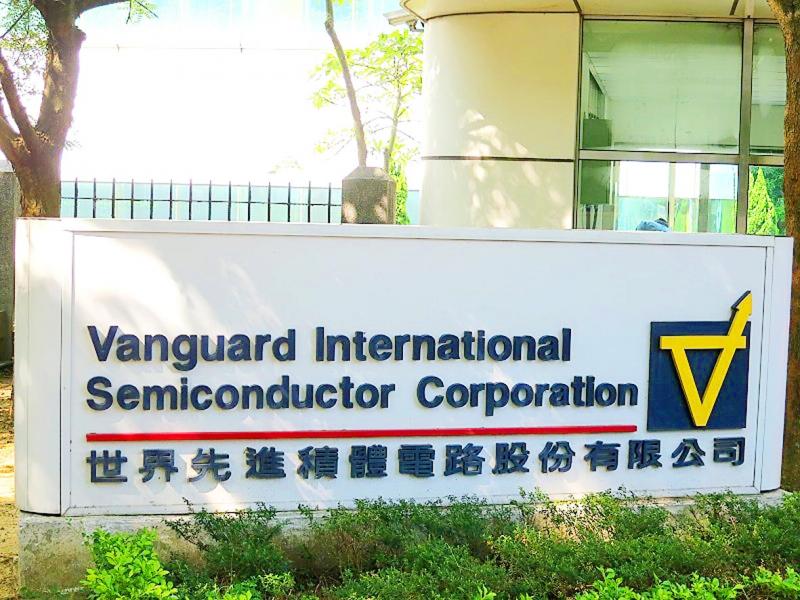Vanguard Semiconductor International Co (世界先進), which makes power management ICs and driver ICs for displays, yesterday said that net profit last quarter fell 1.4 percent from the previous quarter to NT$1.48 billion (US$49.27 million) as a newly acquired fab from GlobalFoundries Inc dragged down gross margin and prices.
Net profit was NT$1.5 billion in the fourth quarter of last year. Despite the quarterly decline, net profit rose 6.4 percent annually from NT$1.39 billion.
Earnings per share fell to NT$0.89 from NT$0.91 the previous quarter, but rose from NT$0.84 a year earlier.

Photo: Hung Yu-fang, Taipei Times
Gross margin dipped to 31 percent last quarter from 36.1 percent the previous quarter, as well as in the first quarter of last year, the company said in a statement.
The chipmaker said that it aims to limit the new fab’s erosion of its gross margin to within 5 percentage points this year.
Vanguard expects gross margin to improve to 31 to 33 percent this quarter, driven by robust customer demand and higher factory utilization of as high as 93 percent, up from about 90 percent a quarter earlier.
“At the moment, we still see our customers showing very strong demand through the second quarter,” Vanguard chairman Fang Leuh (方略) told investors during a teleconference.
“We have two months of [order] visibility until the end of the second quarter,” Fang said.
Vanguard said that it is cautious about customer demand in the second half of the year, given the sliding global economy and climbing unemployment rates worldwide.
“Uncertainty for the second half is huge,” Fang said.
Customers are not cutting orders on any downside risks yet, he added.
Vanguard expects growth momentum to boost revenue by 2 to 7.14 percent to a record high of between NT$8 billion and NT$8.4 billion this quarter, from NT$7.84 billion in the first quarter of this year.
It expects robust demand for power management ICs used in data centers, servers and work-from-home-related devices to fuel growth momentum, the company said.
Growth momentum would also come from driver ICs used in TV displays, as its Chinese display customers are gaining shares after South Korea’s Samsung Electronics Co exited the LCD market, it said.
However, driver ICs used in smartphone displays would be flat or would decline slightly this quarter from last quarter, due to customers’ inventory corrections, Vanguard said.
Power management ICs contributed 55 percent to Vanguard’s total revenue last quarter, while driver ICs for large-sized displays and small-sized displays accounted for 26 percent and 8 percent respectively.
The 8-inch fab in Singapore, which was acquired from GlobalFoundries, is operating normally and is not affected by the city-state’s disease prevention measures, as the semiconductor industry is considered a key industry for Singapore, Vanguard said.

Taiwan Semiconductor Manufacturing Co (TSMC, 台積電) last week recorded an increase in the number of shareholders to the highest in almost eight months, despite its share price falling 3.38 percent from the previous week, Taiwan Stock Exchange data released on Saturday showed. As of Friday, TSMC had 1.88 million shareholders, the most since the week of April 25 and an increase of 31,870 from the previous week, the data showed. The number of shareholders jumped despite a drop of NT$50 (US$1.59), or 3.38 percent, in TSMC’s share price from a week earlier to NT$1,430, as investors took profits from their earlier gains

In a high-security Shenzhen laboratory, Chinese scientists have built what Washington has spent years trying to prevent: a prototype of a machine capable of producing the cutting-edge semiconductor chips that power artificial intelligence (AI), smartphones and weapons central to Western military dominance, Reuters has learned. Completed early this year and undergoing testing, the prototype fills nearly an entire factory floor. It was built by a team of former engineers from Dutch semiconductor giant ASML who reverse-engineered the company’s extreme ultraviolet lithography (EUV) machines, according to two people with knowledge of the project. EUV machines sit at the heart of a technological Cold

Taiwan’s long-term economic competitiveness will hinge not only on national champions like Taiwan Semiconductor Manufacturing Co. (TSMC, 台積電) but also on the widespread adoption of artificial intelligence (AI) and other emerging technologies, a US-based scholar has said. At a lecture in Taipei on Tuesday, Jeffrey Ding, assistant professor of political science at the George Washington University and author of "Technology and the Rise of Great Powers," argued that historical experience shows that general-purpose technologies (GPTs) — such as electricity, computers and now AI — shape long-term economic advantages through their diffusion across the broader economy. "What really matters is not who pioneers

TAIWAN VALUE CHAIN: Foxtron is to fully own Luxgen following the transaction and it plans to launch a new electric model, the Foxtron Bria, in Taiwan next year Yulon Motor Co (裕隆汽車) yesterday said that its board of directors approved the disposal of its electric vehicle (EV) unit, Luxgen Motor Co (納智捷汽車), to Foxtron Vehicle Technologies Co (鴻華先進) for NT$787.6 million (US$24.98 million). Foxtron, a half-half joint venture between Yulon affiliate Hua-Chuang Automobile Information Technical Center Co (華創車電) and Hon Hai Precision Industry Co (鴻海精密), expects to wrap up the deal in the first quarter of next year. Foxtron would fully own Luxgen following the transaction, including five car distributing companies, outlets and all employees. The deal is subject to the approval of the Fair Trade Commission, Foxtron said. “Foxtron will be